The Mystery of Oman Frankincense
By Katlyn Breene
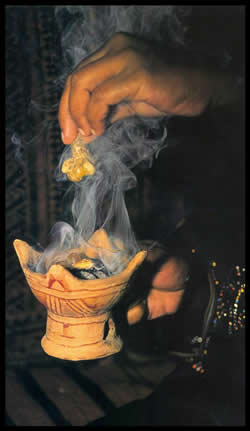
Oman Frankincense, Boswellia Sacra is one of Earth’s greatest treasures. A precious substance revered through the ages.
In the ancient world frankincense was valued more than gold and in our time it is a rare and unique gift. The scent is historically connected with healing and spirituality in almost every culture and religion.
In Oman where the finest Frankincense in the world comes from, it is considered a gift of God. The trees are not intentionally planted or watered, they are nurtured only by nature. The people whose land contains a frankincense tree are considered to be blessed.
Boswellia sacra comes from the Dhofar region of southern Oman Covering about 100,000 square kilometers, the Dhofar region borders Yemen to the west and Saudi Arabia to the north. The trees do not like moisture and thrive in barren areas cooled by sea winds.The ancient twisted trees with crinkly leaves spring unexpectedly to life every September with an explosion of white star flowers. An incision is made into the silvery bark, from which drips the fragrant “pearls”, white globules of resin called luban. Left to dry, this will turn transparent after about two weeks.
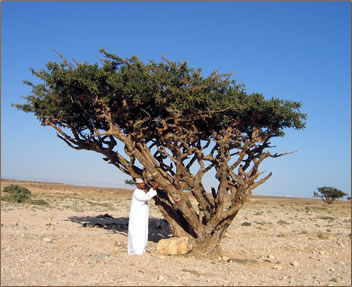
Frankincense can be found in souks (market places) throughout the middle east, but you'll get the premium resin directly from Oman. (as we do at Mermade) The quality, scent and body can be identified by frankincense connoisseurs and, like a fine wine, varies greatly by each season and every year. The best " najd", comes from the hills of the Bait Kathir tribe. The lower quality, shazri, from the Qara mountains and the least valued, sha'abi, is found in the coastal plains. If you ask the experts most will tell you that hougary is the finest.
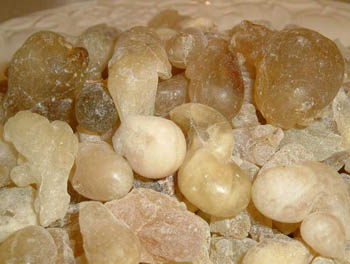
Hougary:
Hougary (also spelled hawjari, hojari, hogary) Oman Frankincense resin is Boswellia sacra - Superior grade frankincense from the Dhofar region of Oman. Considered by many to be the finest frankincense in the world, Hougary is primarily the larger selected white and lemon-white colored frankincense resins.
The highest quality has various tints of green as well. It comes only from Dhofar region of Oman, whose arid growing conditions are ideal for fine quality frankincense resin. Superior Hougary frankincense resins produce beautiful light, bright, citrus aromas with slight underlying woody and balsamic tones. Of the frankincense resins from Oman, Green Hougary is the most sought after of all.
The Scent is described as:
Juliet Highet:
“warm, woody and balsamic, honeyed but not cloying, with an almost austere balancing note of pine and vetiver.”
Arctander:
'It has a fresh balsamic, yet dry and resinous, slightly green odor with a typical, fruity-green top note... of unripe apples .... A certain pepperiness is mellowed with a rich, sweet-woody, balsamic undertone"
“Scents of Place” , Tim Mackintosh-Smith:
"... rich but not cloying, honeyed yet slightly astringent, with hints of lime, vetiver and verbena—the olfactory equivalent of a good sorbet. For thousands of years, this inimitable odor has carried the fame of Arabia across three continents.Even today, Oman is permeated with frankincense. “
From “Scents of Place, Frankincense in Oman”
- by Tim Mackintosh-Smith
In the Souk...
“I listened as Radiyyah went through the different grades of frankincense in her stock. "Those yellow lumps aren't so good," she said. "These are better. Look, they're like pearls. But," she opened a small box, "these are the real fusus" Her word "gems" was well chosen: Teardrops the size of fat ring-stones, some were silvery, others had opalescent hints of rose, green or amber. "This is najdi," she explained, "from the najd [plateau], the high land behind Jabal Qara." She pointed to the range of mountains across the plain from Salalah. I had already made inquiries about where the best frankincense comes from. My informants, however, could not agree. In Jabal Qara, one had said that the best came from Mughsayl, west of Salalah. A farmer near Mughsayl said that the best came from 'Aydam, nearer the border with Yemen. The literary sources were similarly in disagreement. "The finest luban of all you won't find in the suq," added Radiyyah, confusing the matter further. "It's called hawjari and it comes from around Hasik."
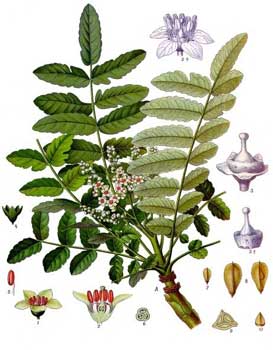
“The Tree of Life”
Frankincense because of its non-perishability its resistance to bacteria and because it is an evergreen tree, it is a symbol of immortality. The tree can live for at least 100 years. It seems that the power and beauty Frankincense is a reflection of its intense tenacity for life. In the driest areas, it condenses the solar heat and chill night winds into a rare essence. The gnarled exterior is in great contrast with its inner spirit.
The Omani say of Frankincense:
“From my branches flows the fluid to which millions of hearts beat on hearing its name”
Burning Frankincense
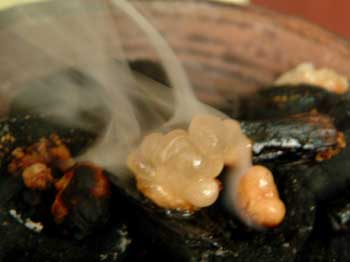
Using Charcoal
Prepare a censer or fireproof dish, we have several types available at Mermade that we have found to work the best. Adding sand or white ash to the censer is a good idea. It absorbs heat from the censer and lets air under the charcoal for better burning. Or use a resin censer which has a screen on top to let the ashes fall through in to the censer bowl. Frankincense is one incense that burns very well on charcoal and the smoke itself is very intoxicating. Try to use a high quality charcoal disk or tablet like the chemical free bamboo tablets from Japan or the type used for Hookahs which have a very small amount quick lighting agents in them. In the Middle East coals are taken right from the home’s hearth are used. Types like Three Kings (from church and occult supply stores) have the highest chemical content.
To light the charcoal use pinchers or tongs, chopsticks (wood or metal) work very well for this. Hold it over a candle flame turning it gently until it begins to glow around the edges. then place it in your censer and wait until it has a white ash coating evenly over its surface.
We like to have a special place in our home for burning incense a “scented altar” where all the supplies are containers are kept. Make the lighting of incense a daily ritual and it will continually bless and uplift the atmosphere of your home.
When the charcoal is ready (in about 4-5 minutes) place the frankincense directly on the coal or use a piece of thin foil on top of the charcoal to let the resin burn more slowly - then let the wonderful scent arise.
Hougary comes in large roundish hunks or tears and we recommended that you breakup or grind it slightly before burning to allow it burn evenly and disperse its scent quickly. Though you can place a whole tear on an electric heater, incense stove or candle heater and it will slowly melt and release its heavenly scent.
Electric Incense Heaters
Electric heaters are now available at a reasonable price and are highly recommended for getting the most from fine natural incense of all types. It is especially desirable to use with delicate woods and botanicals. The heater allows them to realize their essential oils before combustion. Many things that are not very aromatic when burned on charcoal have a lovely aroma on a heater. Resins are warmed slowly and a richer scent will be exuded for a longer period of time. Although with some incense botanicals smoke is desired , with many, smoke means the end of the release of the essential oils that carry all the fragrance. So if you want the most from your incense material use a temperature controlled electric heater.
When using a heater be sure to experiment with the temperatures for different types of incense, always preheat and start with a setting below 30. If your incense begins to smoke too quickly turn down or off completely. It is best to try it for yourself and find what works for you.
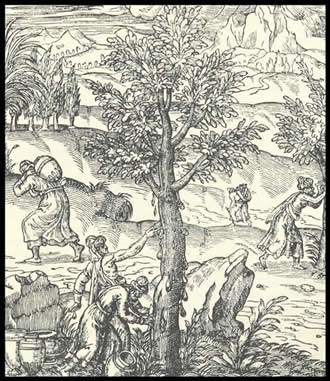
From “Frankincense, Oman’s Gift to the World” by Juliet Highet:
“At the apex of the trade, three thousand tons of the incense were recorded to have been exported annually to the Roman Empire alone. This frankincense came primarily from the Dhofar region of what is now southern Oman, thousands of kilometers south across mountains and the Rub' al-Khali, the vast, notorious Empty Quarter. Dhofar is where the best-quality product known as 'silver incense' is grown, described by the Roman writer Pliny as 'brilliant white and gathered at dawn in drops or tears in the shape of pearls Why were these 'pearls', these little pieces of resin, so prized that Alexander the Great planned to invade Arabia in order to control the trade in incense at its point of origin? Only Alexander's death prevented him from fulfilling his ambition of attaining such treasure.” Why would a Roman centurion be prepared to spend half his monthly salary on a pound weight of the stuff? Indeed, why did the Roman Senate send an army to colonize “Arabia Felix”. Happy Arabia, believed to be a land of unparalleled wealth- an army which got lost among the mirages of the Empty Quarter? In the first century BCE, the powerful king of today's Yemen did invade Oman in order to control the trade, establishing a fortified outpost there. Earlier still, in the tenth century BC the legendary visit of the Queen of Sheba from her Sabaean kingdom in Yemen to King Solomon was ostensibly to test his wisdom, but almost certainly to secure an agreement on frankincense and myrrh advantageous to both parties. Sheba's spectacular wealth depended on control of the trade along her sector of the Incense Road.”
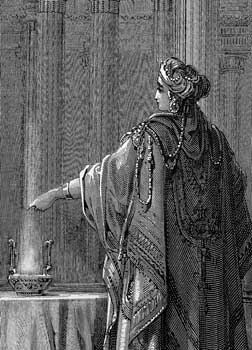
In the Ancient World
Egyptians believed that incense was the very 'sweat of the gods', and that their souls would ascend to Ra on the wings of smoking resin. Funerary rites were therefore inconceivable without vast quantities of frankincense the 'stairway to the sky “There were also the pleasures of personal use..
The ancient world believed that frankincense pleased their gods. Since smoke rises to heaven, incense was considered the natural vehicle to carry prayers to the home of the gods, literally a pathway for prayer. As the Arab historian, Al-Tabari, wrote: 'Incense smoke reaches the heavens like no other”
In Ancient Egypt it was 'the one who makes God known”. It was especially prized by the Egyptians for its connection to the Sun God Ra. Egyptians believed that their souls would fly up to Ra on the wings of the smoke, which ascended every morning to honor the dawn. Holding long-handled censers called anischirs containing smoldering charcoal, the priests applied and reapplied frankincense while praying. As the sun rose, they would 'awaken' statues of the deities by passing the arnschirs beneath their noses. As the smoke spiraled upwards, and the solid crystals turned into perfumed clouds linking the material world below with the invisible domain of the gods above, they were inhaling the prayers.
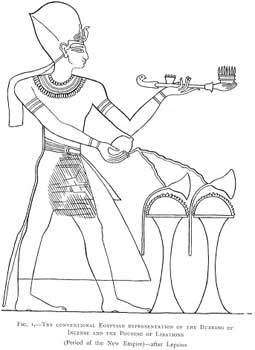
In temples for the Babylonian Sun god Baal and the Greek Apollo, frankincense was burnt in large quantities as an alchemical substance with the power to bring devotees closer to divinity. From the Egyptian courts the Hebrews, and then the Greeks and Romans, had learnt not only of the sensual delights of perfume, but the practical applications as well.
For the ancient Greeks, the word 'scent' itself meant 'offering to the gods” - Libanos
The incantation performed over the burning incense glorifies the part played by it:
The incense comes, the incense comes.
The scent is over thee,
The scent of the eye of Horus is over thee.
The perfume of the goddess Nekhbet
Which comes forth from the town of Nekheb it cleanses thee, it adorns thee,
It makes its place upon thy two hands.
Hail to thee, oh incense!
Take to thyself the eye of Horus. Its perfume is over thee.
This text is written on an offering table on which the bowl of incense was probably placed. Burning and offering incense was a means of communication between the earthly and the divine spheres.
ISIS INCENSE OFFERING IN EGYPTIAN
ISIS!
THOU WHO ART THE GUARDIAN
OF THE FOUR WATCHERS-
LET ME OFFER INCENSE UNTO THE GODDESS ISIS...
NAS-I AST, ME-KHET EN AST-
ME-UNFU EM TA AST MA-AN-RAT
AST, ME-UNFU EN MAHET
EN AAB HEKA SHEN-ATEN.
HERI BAH EN AST, MA QET QN AST,
ME-KHET EN MAAT AST, ME QET EN AST...
Uses of Frankincense in the Middle East:
- Frankincense burners, from the large ones that can be borne on the head during a procession to tiny shallow bowls that burn only a granule or two of the gum, are made of clay.
- Historically the preferred shapes were produced artificially - lumps of softened gum being molded together, small pieces put into a clay pot and rolled around until they had joined into a single lump and taken on the curve of the pot, or liquid, soft frankincense was made into artificial "tears" by being shaken in a basket.
-Lumps of fresh, moist frankincense were molded into a rough cone-shape, and one or two of these would be ignited as darkness fell - this gum "candle" burned steadily throughout the night providing minimal light and keeping at bay the dangerous animals and malevolent spirits which roamed the night.
Healing with Frankincense:
-The gum was used in the treatment of almost every imaginable disease by Greek and Roman physicians, and remedies employing frankincense also appear in the Syriac Book of Medicine, in the text of Muslim practitioners of the Middle Ages, and in Indian and Chinese medical writings.
- Recent research has revealed that the principle ingredient 0f gums such as frankincense and myrrh are very similar in chemical structure to the human steroid molecule, testosterone, the hormone which drives both male and female libido.
- The fresh gum is chewed for strengthening the teeth and gums, to stimulate digestion and to combat halitosis.
- The smoke from the burning gum is considered to have powerful curative and protective properties. Sick humans or domesticated animals are customarily fumigated with incense.
- Frankincense was and still is very far from being just a lovely fragrance; not is its extraordinary symbolic value confined to its healing powers, which range from treatment of psychological conditions such as depression and claustrophobia to physical ones such as eczema and abscesses.
- Smoke of gum is inhaled by people suffering from headache.
- Frankincense acts upon the the nervous system. and has the ability to relax yet revitalize . It smoothes the flow of stagnant Chi or Qi (the vital force of the human body).
- It is the great purifier of body and mind.
Cosmetic Uses
- Tattoos: areas of skin were pierced with two needles held close together and the perforations were then rubbed with soot from frankincense gum to make a permanent mark.
- In Dhofar, the soot of the gum was collected in a pot held inverted over the burning gum and then scraped off and used to make eye antimony. (kohl)
- In all the Middle East, frankincense is one of the most prominent fragrances. Wooden fumigating tripods are used to perfume and fumigate clothing. A special incense burner is placed at the base and clothes are layered above.
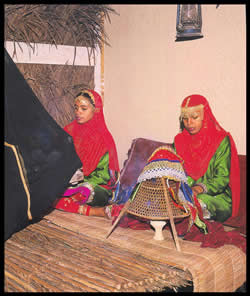
- Distilled and extracted to yield essential oil, resinoid, and absolute. Valued for its distinct oriental notes as well as fixative qualities. In Oman a very costly perfume is now prepared using these aromatic oils. It is called Amourage and enjoys and international reputation.
- Used to prepare a hair oil which helped fix the hair tight against the head and give it a gleaming appearance.
- A special talcum powder is prepared using frankincense, spices and ammonium salts to perfume and soften the skin.
- Visitors are often offered bowls of burning frankincense in Dhofar. The men waft the smoke about their beard, head and chest, while women perfume their headshawls and in less formal gatherings, stand over the bowl holding their dress closed at the neck to trap the fragrant smoke inside.
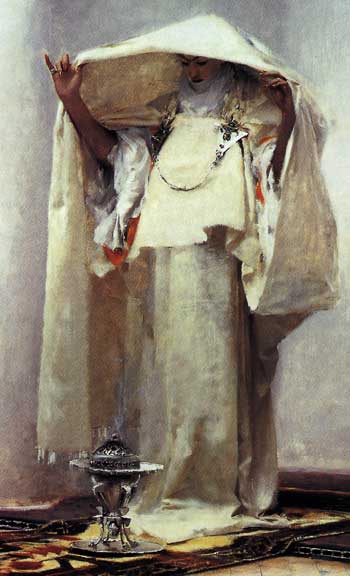
The Scent of Spirituality
- Frankincense is a wonderful aid to meditation and spiritual practice. It is associated with the third eye chakra and aids in “opening the doors of perception to transcendence”.
- “Frankincense accesses a higher state of consciousness, connecting the individual to universal spirituality. On a practical level, with its ability to still the mind and deepen the breath, it aids contemplation and meditation. Frankincense, the ancient pathway to prayer, still has the potential to enable the soul to soar.”
- Juliet Highet
- Smoke is a symbol of the union of heaven and earth, spirit and matter. Smoke columns are sometimes associated symbolically with the World Axis
The Recent Findings on the Beneficial Effects of Frankincense
From "Think Gene" - posted by Josh hill
- “Religious leaders have contended for millennia that burning incense is good for the soul. Now, biologists have learned that it is good for our brains too. In a new study appearing online in The FASEB Journal (http://www.fasebj.org), an international team of scientists, including researchers from Johns Hopkins University and the Hebrew University in Jerusalem, describe how burning frankincense (resin from the Boswellia plant) activates poorly understood ion channels in the brain to alleviate anxiety or depression. This suggests that an entirely new class of depression and anxiety drugs might be right under our noses. “In spite of information stemming from ancient texts, constituents of Boswellia had not been investigated for psychoactivity,” said Raphael Mechoulam, one of the research study’s co-authors. “We found that incensole acetate, a Boswellia resin constituent, when tested in mice lowers anxiety and causes antidepressive-like behavior. Apparently, most present day worshipers assume that incense burning has only a symbolic meaning.”
Burning of Boswellia resin as incense has been part of religious and cultural ceremonies for millennia and is believed to contribute to the spiritual exaltation associated with such events. RESEARCH ON PLANTS ELICITING psychoactive effects, such as Cannabis sativa, Papaver species, and Nicotiana tabacum, has provided important insights into neurochemical processes and diseases of the central nervous system (CNS) (1) . Psychoactive plant drugs have also played a major role in religious customs in many ancient cultures, as they exert a profound effect on human consciousness, emotions and cognition. Notable examples of plants that were used in religious rituals are the mythological Aryan soma, Ipomoea linnaeus (the source of South American ololiuqui), Cannabis sativa, Salvia divinorum (the source of divinorin) (2) , Nicotiana tabacum (3) , and several Boswellia species. The resin of Boswellia species (Burseraceae; "frankincense" and "olibanum") is mentioned in numerous ancient texts as incense by itself or as a major component of incense (4) . In the ancient Middle East, Boswellia resin was considered a highly precious commodity, carried in caravans from sub-Sahara regions, where it is still a major export product (5) . In ancient Egypt, incense burning signified a manifestation of the presence of the gods and a gratification to them. In ancient Judea, it was a central ceremony in the temple. The ancient Greeks used incense burning as an oblation. In Christendom, its use in worship has continued since the fourth or fifth century C.E (6) .
The psychoactivity of Boswellia was already recognized in ancient times. Dioscorides (first century C.E.) writes that it causes madness (7) . In the Jewish Talmud (300–600 C.E.), Boswellia resin is mentioned as a potion (in wine) given to prisoners condemned to death to "benumb the senses" (8) . In Ethiopia, where Boswellia trees are indigenous, it is believed to have a tranquilizing effect .
In view of the prolonged use of Boswellia, its historical importance, and its significance in cultural and religious rituals along with its purported pharmacological effects, we investigated the biochemical profile and psychoactivity of purified components of Boswellia resin. We assumed that the spiritual exaltation caused by incense burning in religious ceremonies would be enhanced by putative pharmacological effects of its constituents, particularly on the conductors of the ceremonies, who presumably inhale large amounts of smoke. We are unaware of any attempt to identify constituents with an effect on sensation or emotion. Menon and Kar (10) have reported that an ether extract of Boswellia serrata resin produces analgesic and sedative effects in rats, but the compounds causing these effects have not been isolated.
We examined Boswellia extract for the presence of novel bioactive components and isolated incensole acetate (IA) as a major active constituent of Boswellia resin.
Molecular image of Frankincense Resin - a very beauiful and revealing photo
Traditional Social and Religious Uses
- In Dhofar visitors are offered bowls of burning incense. Men waft the smoke about their beards, chest, and heads. Women perfume their head shawls and in less formal circumstances stand over the brazier and trap the smoke under their gowns rendering themselves odiferous.
- A very special grade of frankincense is kept in special containers for important occasions. One of these is the when children have to recite long passages from the Holy Qur'an. The night before the examination several of the precious frankincense pearls are soaked in water with iron. The first thing in the morning the child to be examined drinks the liquid which is said to improve the memory and improve chances of success.
- Frankincense is burned when people swear an oath. It is also burned at the shrines of revered holy men.
- It is burned at wedding and religious occasions. Said to keep away all evil influences and attract wholesome ones.
- Clay and wooden water vessels are regularly purified with frankincense smoke. After being cleaned and scrubbed frankincense burners are lowered into them and the vessels sealed so that the smoke thoroughly permeates the vessels. As soon as the burners are removed fresh water is poured in and the vessels once again thoroughly covered.
- Byzantine Church Style Incense begins with pure frankincense tears, imported botanical extracts, & fragrant wood resins. Pure frankincense resin is ground into a fine powder, which is then saturated with rich fragrant oil. Kneading this mixture by hand, it is brought to a dough-like consistency. It is then time for the rolling and cutting of the incense. The monks begin their work with prayer, and continue to pray as they roll and cut the incense. The grains of incense now covered with the finest fire-purified clay powder to mitigate the stickiness of the mixture, are cured for a minimum of 30 days. This cured incense, rich in fragrance is then prayerfully prepared and packaged.
- Almost every Church incense contains frankincense, sourced from Somalia and Eritrea, 'because Omani frankincense is too fragrant', said Father Thomas. He explained how church incense is created today: 'I take the frankincense crystals and grind them to powder in a coffee grinder. Then I weigh out the powder and measure the oils according to the formula ratio. I mix them up and roll them into a large "sausage", which is kept in the refrigerator for two to three days, to help the crystals re-form. Then I chop it into four, warm the segments gently, and roll them out thinner and thinner. With scissors, I cut them into tiny pellets. These are left on trays for six months to dry out. Finally, I bag them up with clay powder, to prevent them sticking together.
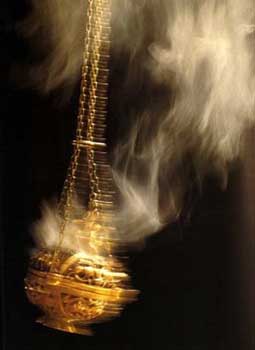
Frankincense Etymology
Derived from the Old French "franc encens", meaning pure incense or, more literally, free lighting NOUN : An aromatic gum resin obtained from African and Asian trees of the genus Boswellia and used chiefly as incense and in perfumes.
ETYMOLOGY: Middle English frank encens, from Old French franc encens, franc, free, pure
ADJECTIVE : Inflected forms: frank-er, frank-est
1. Open and sincere in expression; straightforward
2. Clearly manifest; evident
ETYMOLOGY: Middle English, free, from Old French franc, from Late Latin Francus, Frank.
NOUN : 1. a. An aromatic substance, such as wood or a gum, that is burned to produce a pleasant odor. b. The smoke or odor produced by the burning of such a substance.
2. A pleasant smell.
3. Flattering or fawning attention; homage.
TRANSITIVE VERB : Inflected forms: ‹censed, ‹cens·ing, ‹cens·es
1. To perfume with incense.
2. To burn incense to, as a ritual offering.
ETYMOLOGY: Middle English encens, from Old French, from Latin incensum, from neuter past participle of incendere, to set on fire.
2. INCENDIARY, INCENSE; from Latin compound incendere, to set fire to, kindle from transitive candere, to kindle.
Preservation and Sustainability of Frankincense
Frankincense is now becoming an endangered botanical and there is conscious effort to preserve this precious harvest. It needs to be protected from over harvesting, camels and the animal herds of nomadic tribes.
One of the four World Heritage Sites inscribed by UNESCO as The Land of Frankincense is Wadi Dhowkah. It is classified as a 'frankincense natural park', and was selected because 0f its comparative density 0f trees and the vicinity 0f the National Highway from Salalah to Muscat. About twenty-five kilometres north of Salalah, the flat wadi drains to the north behind north-facing cliffs, sheltered from the monsoon. This is ideal for the production of high-quality incense.
Mermade Offers Fine Omani Frankincense:
Today practically all of the commercially available frankincense comes from Somalia which is lower quality and less expensive . Omani frankincense still exists but usually only in the local souk (market) where it is available to locals and tourists. The Omani Government exports only limited amounts and it is left to individual companies to revive this ancient trade of Omani frankincense - the finest available.
It is accepted that Hougary frankincense from Dhofar is the highest quality available in the world and we are proud to make it available to our customers . It is in almost all of our incense blends. We know it is an aromatic experience that will draw you back again and again.

Scented quotes...
I do not feel like writing today
but as I light my censer with myrrh , frankincense and jasmine
words suddenly bloom from my heart
like flowers in a garden.
- Hafiz
"Accompany your prayer with perfume and your words will reach God transported by an odorous exhalation telling him of your gratitude and devotion"
- the Vedas of India
"Frankincense, myrrh, cassia, cinnamon, and labdanum grow in Arabia alone of all countries. ... Over the trees that bear frankincense winged snakes stand guard, small in size and varied in appearance, a mass of them about each tree"
(Herodotus 3.107; 5th cent.BC; transl. by L.Casson).
“Though the woman wore a long, hooded black dress, she was unveiled. A gold ring pierced her nose, her eyes shone with self-assurance. She was the settlement's matriarch. With brass tongs she picked embers from the fire and placed them in a brightly painted clay incense burner shaped like a horned altar. The she added crystals of frankincense, which glowed brightly and immediately gave rise to a fragrant smoky plume. All the while she chattered with the two men in the Shahra's strange 'language of the birds.'
"Incense is most pleasing to God," she said, adding more crystals.
"But enough, woman, enough!" interjected one of the men, his eyes smarting from the smoke. "Too bad for you," she said laughing, and led the way outside.”
- Christopher McMahon
White Lotus archive
And rare Arabian odors came,
Through the myrtle copses, steaming thence
From the hissing frankincense,
Whose smoke, wool-white as ocean foam,
Hung in dense flocks beneath the dome--
That ivory dome, whose azure night
With golden stars, like heaven, was bright
O'er the split cedar's pointed flame;
And the lady's harp would kindle there
The melody of an old air,
Softer than sleep; the villagers
Mixed their religion up with hers,
And, as they listened round, shed tears.
- P.B. Shelley
What is this, coming up from the desert,
Like a column of smoke,
Laden with myrrh, with frankincense
And with the perfume of every exotic dust?
Your are the park that puts forth Pomegranates,
With all choice fruits;
Spikenard and saffron, calamus and Cinnamon,
Myrrh and aloes with all the fine spices.
You are garden fountain, a well of water,
Flowing fresh from Lebanon.
Arise, north wind! Come, south wind!
Blow upon my garden,
That its perfume may spread abroad.
- The Song of Songs 3:6
Sources and Recommended Reading:
"Frankincense & Myrrh" by Martin Watt and Wanda Sellar
"Frankincense: Oman's Gift to the World " by Juliet Highet
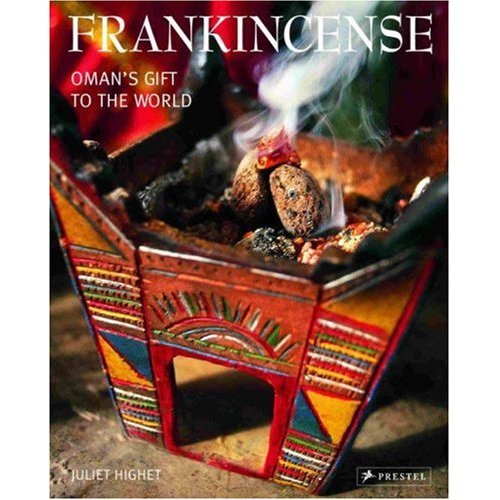
Incense Making .com
http://incensemaking.com
White Lotus Aromatics Newsletter
http://www.whitelotusaromatics.com/newsletters/frankincense
"Sacred Luxuries, Fragrance, Aromatherapy and Cosmetics in Ancient Egypt" by Lise Manniche
SEPASAL Database - Frankincense
http://www.rbgkew.org.uk/ceb/sepasal/bsacra
“Scents of Place” by Tim Mackintosh-Smith